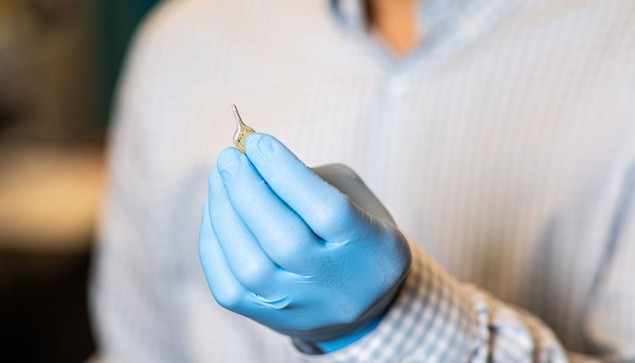The implantable device delivers personalized photodynamic therapy
10 May 2022

Researchers in the US, UK and South Korea have designed a wireless, implantable optoelectronic device that can effectively deliver photodynamic therapy (PDT) to cancer cells. Led by Sung Il Park at Texas A&M University, the team showed how their device could be used to reliably treat tumors in any part of the body, using precisely targeted illumination.
Unlike chemotherapy, which is often given in conjunction with surgery but can lead to toxic side effects, PDT specifically targets cancer cells while minimizing damage to surrounding healthy tissue. PDT involves administering a photosensitive drug, which is preferentially taken up by and retained in cancer cells. This photosensitizer is then activated by irradiation with light of a specific wavelength, causing it to release reactive oxygen species that kill the surrounding cancer cells.
The main difficulty faced by this technique lies with the ability to deliver light effectively to the photosensitizer – which is often located deep within the body. While advances in wireless technology allow light to be delivered remotely from implantable devices, it is still difficult to produce light that specifically targets the photosensitizer, leading to low levels of activation. In addition, the clinical application of PDT has been limited by a lack of methods to monitor tumor response and adjust light dosage accordingly.
To overcome these issues, Park’s team has designed a low-power, wireless LED device for photosensitizer activation. The device’s operation is informed by DeepLabCut (DLC), an algorithm that estimates the poses of freely moving animals in real time, and a Monte Carlo thermal/light simulation platform that simulates the responses of photosensitizers to the light that they receive.
With this software combination, Park and colleagues demonstrated how the implantable devices could be tailored to the responses of individual tumors. Depending on the size of a tumor, and the photosensitizer used to treat it, they showed how bespoke devices could be optimized to produce a suitable combination of light sources and wavelengths to maximize photosensitizer activation.READ MORE

The researchers evaluated the device performance using mouse models of colorectal cancer-producing up to a 76% decrease in tumor volume after five days of continuous dual-wavelength PDT treatment. Based on these results, they have now established a new set of guidelines for the effective delivery of PDT.
In the long term, the team hopes that its work will create a platform that could improve cancer-monitoring capabilities outside of carefully-controlled hospital and lab facilities. In addition, it could help to prevent the re-emergence of tumors located in any part of the body – significantly improving the quality of life for people living with many different types of cancer.
The researchers report their findings in Nature Communications.
Sam Jarman is a science writer based in the UK.
from physicsworld.com 13/5/2022
Δεν υπάρχουν σχόλια:
Δημοσίευση σχολίου